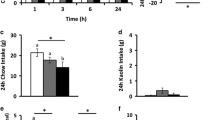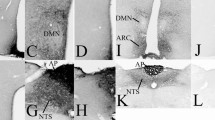Abstract
The mechanism by which blood-borne peptide YY (3–36) (PYY(3–36)) and pancreatic polypeptide (PP) inhibit food intake is not clear and could implicate peripheral (vagal afferent pathways) and/or central (direct action on specific brain nuclei) mechanisms. To identify the primary brain structure(s) that could be activated after a peripheral injection of neuropeptide Y-related peptides, we investigated the distribution of radioactive materials using whole body autoradiography and coronal brain sections. Rats were injected with [125I] porcine (p) PYY(3–36) (i.p., 10 μCi) and killed after 30 min, 1, 2, or 4 h. After i.p. administration, significant amounts of radioactive materials were rapidly (<30 min) detected in the blood circulation and various tissues including the kidneys, liver, lung, heart, bone marrow, gastrointestinal tract, and thyroid gland, whereas in the brain, low but significant amounts of radioactive materials were detected at the level of the area postrema. Next, we investigated the distribution of radioactive labeling in the brain after i.v. injections of [125I]pPYY(3–36) (Y2 and Y5 subtypes), [125I] human (h) PP (Y4 and Y5 receptors), and [125I][Leu31, Pro34] pPYY (Y1, Y4 and Y5 classes) in the rat brain. Fifteen minutes post injection, autoradiograms revealed positive signals only in the area postrema after the injection of [125I]-hPP and [125I][Leu31, Pro34]pPYY. Whereas the presence of [125I]pPYY(3–36)-related labeling was detected in the area postrema, subfornical organ, and median eminence. In all other brain structures, including all hypothalamic nuclei and other circumventricular organs, near background level signals were detected. These data suggest that the inhibition of food intake observed after peripheral injections of pPYY(3–36) and hPP could involve receptor activation preferentially located at the level of the area postrema, a structure well-known to be involved in the modulation of food intake.







Similar content being viewed by others
References
Abbott, C. R., Monteiro, M., Small, C. J., et al. (2005a). The inhibitory effects of peripheral administration of peptide YY(3–36) and glucagon-like peptide-1 on food intake are attenuated by ablation of the vagal–brainstem–hypothalamic pathway. Brain Research, 1044, 127–131.
Abbott, C. R., Small, C. J., Kennedy, A. R., et al. (2005b). Blockade of the neuropeptide Y Y2 receptor with the specific antagonist BIIE0246 attenuates the effect of endogenous and exogenous peptide YY((3–36)) on food intake. Brain Research, 1043, 139–144.
Abdulla, F. A., Moran, T. D., Balasubramanyan, S., & Smith, P. A. (2003). Effects and consequences of nerve injury on the electrical properties of sensory neurons. Canadian Journal of Physiology and Pharmacology, 81, 663–682.
Adrian, T. E., Savage, A. P., Bacarese-Hamilton, A. J., Wolfe, K., Besterman, H. S., & Bloom, S. R. (1986). Peptide YY abnormalities in gastrointestinal diseases. Gastroenterology, 90, 379–384.
Alderdice, J. T., Dinsmore, W. W., Buchanan, K. D., & Adams, C. (1985). Gastrointestinal hormones in anorexia nervosa. Journal of Psychiatric Research, 19, 207–213.
Allison, D. B., & Saunders, S. E. (2000). Obesity in North America. An overview. Medical Clinics of North America, 84, 305–331.
Asakawa, A., Inui, A., Yuzuriha, H., et al. (2003). Characterization of the effects of pancreatic polypeptide in the regulation of energy balance. Gastroenterology, 124, 1325–1336.
Banks, W. A., Kastin, A. J., & Jaspan, J. B. (1995). Regional variation in transport of pancreatic polypeptide across the blood–brain barrier of mice. Pharmacology, Biochemistry and Behavior, 51, 139–147.
Batterham, R. L., Cohen, M. A., Ellis, S. M., et al. (2003a). Inhibition of food intake in obese subjects by peptide YY3–36. New England Journal of Medicine, 349, 941–948.
Batterham, R. L., Cowley, M. A., Small, C. J., et al. (2002). Gut hormone PYY(3–36) physiologically inhibits food intake. Nature, 418, 650–654.
Batterham, R. L., Le Roux, C. W., Cohen, M. A., et al. (2003b). Pancreatic polypeptide reduces appetite and food intake in humans. Journal of Clinical Endocrinology and Metabolism, 88, 3989–3992.
Berthoud, H. R., Sutton, G. M., Townsend, R. L., Patterson, L. M., & Zheng, H. (2006). Brainstem mechanisms integrating gut-derived satiety signals and descending forebrain information in the control of meal size. Physiology & Behavior, 89, 517–524.
Bonaz, B., Taylor, I., & Tache, Y. (1993). Peripheral peptide YY induces c-fos-like immunoreactivity in the rat brain. Neuroscience Letters, 163, 77–80.
Cabrele, C., Langer, M., Bader, R., et al. (2000). The first selective agonist for the neuropeptide Y Y5 receptor increases food intake in rats. Journal of Biological Chemistry, 275, 36043–36048.
Carvajal, C., Dumont, Y., & Quirion, R. (2006). Neuropeptide Y: role in emotion and alcohol dependence. CNS & Neurological Disorders—Drug Targets, 5, 181–195.
Challis, B. G., Coll, A. P., Yeo, G. S., et al. (2004). Mice lacking pro-opiomelanocortin are sensitive to high-fat feeding but respond normally to the acute anorectic effects of peptide-YY(3–36). Proceedings of the National Academy of Sciences of the United States of America, 101, 4695–4700.
Challis, B. G., Pinnock, S. B., Coll, A. P., Carter, R. N., Dickson, S. L., & O’Rahilly, S. (2003). Acute effects of PYY(3–36) on food intake and hypothalamic neuropeptide expression in the mouse. Biochemical and Biophysical Research Communications, 311, 915–919.
Chaudhri, O., Small, C., & Bloom, S. (2006). Gastrointestinal hormones regulating appetite. Philosophical Transactions of the Royal Society of London. Series B, Biological Sciences, 361, 1187–1209.
Chelikani, P. K., Haver, A. C., & Reidelberger, R. D. (2005). Intravenous infusion of peptide YY(3–36) potently inhibits food intake in rats. Endocrinology, 146, 879–888.
Clark, J. T., Kalra, P. S., Crowley, W. R., & Kalra, S. P. (1984). Neuropeptide Y and human pancreatic polypeptide stimulate feeding behavior in rats. Endocrinology, 115, 427–429.
Cox, J. E., & Randich, A. (2004). Enhancement of feeding suppression by PYY(3–36) in rats with area postrema ablations. Peptides, 25, 985–989.
Dumont, Y., Cadieux, A., Doods, H., et al. (2000a). BIIE0246, a potent and highly selective non-peptide neuropeptide Y Y2 receptor antagonist. British Journal of Pharmacology, 129, 1075–1088.
Dumont, Y., Chabot, J. G., & Quirion, R. (2004a). Receptor autoradiography as mean to explore the possible functional relevance of neuropeptides: Focus on new agonists and antagonists to study natriuretic peptides, neuropeptide Y and calcitonin gene-related peptides. Peptides, 25, 365–391.
Dumont, Y., Fournier, A., St Pierre, S., & Quirion, R. (1996). Autoradiographic distribution of[125I][Leu31,Pro34]PYY and [125I]PYY3–36 binding sites in the rat brain evaluated with two newly developed Y1 and Y2 receptor radioligands. Synapse, 22, 139–158.
Dumont, Y., Jacques, D., St Pierre, J. A., Tong, Y., Parker, R., Herzog, H., et al. (2000b). Neuropeptide Y, peptide YY and pancreatic polypeptide receptor proteins and mRNAs in mammalian brains. In R. Quirion, A. Bjorklund & T. Hokfelt (Eds), Handbook of chemical neuroanatomy, Vol 16 Peptide Receptors, Part 1) (pp. 375–475). London, UK: Elsevier.
Dumont, Y., Moyse, E., Fournier, A., & Quirion, R. (2005). Evidence for the existence of an additional class of neuropeptide Y receptor sites in the rat brain. Journal of Pharmacology and Experimental Therapeutics, 315, 99–108.
Dumont, Y., & Quirion, R. (2000c). [125I]-GR231118: a high affinity radioligand to investigate neuropeptide Y Y1 and Y4 receptors. British Journal of Pharmacology, 129, 37–46.
Dumont, Y., & Quirion, R. (2006). An overview of neuropeptide Y: pharmacology to molecular biology and receptor localization. EXS, 95, 7–33.
Dumont, Y., Thakur, M., Beck-Sickinger, A., Fournier, A., & Quirion, R. (2004b). Characterization of a new neuropeptide Y Y5 agonist radioligand: [(125)I][cPP(1–7), NPY(19–23), Ala(31), Aib(32), Gln(34)]hPP. Neuropeptides, 38, 163–174.
Dutton, M. A., Lee, E. W., & Zukowska, Z. (2006). NPY and extreme stress: lessons learned from posttraumatic stress disorder. EXS, 95, 213–222.
El Salhy, M., Suhr, O., & Danielsson, A. (2002). Peptide YY in gastrointestinal disorders. Peptides, 23, 397–402.
Glaser, B., Zoghlin, G., Pienta, K., & Vinik, A. I. (1988). Pancreatic polypeptide response to secretin in obesity: effects of glucose intolerance. Hormone and Metabolic Research, 20, 288–292.
Halatchev, I. G., & Cone, R. D. (2005). Peripheral administration of PYY3–36 produces conditioned taste aversion in mice. Cell Metabolism, 1, 159–168.
Halatchev, I. G., Ellacott, K. L., Fan, W., & Cone, R. D. (2004). Peptide YY3–36 inhibits food intake in mice through a melanocortin-4 receptor-independent mechanism. Endocrinology, 145, 2585–2590.
Ishiguchi, T., Amano, T., Matsubayashi, H., Tada, H., Fujita, M., & Takahashi, T. (2001). Centrally administered neuropeptide Y delays gastric emptying via Y2 receptors in rats. American Journal of Physiology. Regulatory, Integrative and Comparative Physiology, 281, R1522–R1530.
Ishihara, A., Kanatani, A., Mashiko, S., et al. (2006). A neuropeptide Y Y5 antagonist selectively ameliorates body weight gain and associated parameters in diet-induced obese mice. Proceedings of the National Academy of Sciences of the United States of America, 103, 7154–7158.
Jolicoeur, F. B., Bouali, S. M., Fournier, A., & St Pierre, S. (1995). Mapping of hypothalamic sites involved in the effects of NPY on body temperature and food intake. Brain Research Bulletin, 36, 125–129.
Kalra, S. P., & Kalra, P. S. (2006). Neuropeptide Y: A conductor of the appetite-regulating orchestra in the hypothalamus. In A. J. Kastin (Ed), Handbook of biologically active peptides (pp. 889–894). San Diego, CA: Elsevier.
Kanatani, A., Ishihara, A., Asahi, S., Tanaka, T., Ozaki, S., & Ihara, M. (1996). Potent neuropeptide Y Y1 receptor antagonist, 1229U91: blockade of neuropeptide Y-induced and physiological food intake. Endocrinology, 137, 3177–3182.
Kanatani, A., Kanno, T., Ishihara, A., et al. (1999). The novel neuropeptide Y Y(1) receptor antagonist J-104870: a potent feeding suppressant with oral bioavailability. Biochemical and Biophysical Research Communications, 266, 88–91.
Kastin, A. J., & Akerstrom, V. (1999). Nonsaturable entry of neuropeptide Y into brain. American Journal of Physiology. Endocrinology, Metabolism, 276, E479–E482.
Koda, S., Date, Y., Murakami, N., et al. (2005). The role of the vagal nerve in peripheral PYY3–36-induced feeding reduction in rats. Endocrinology, 146, 2369–2375.
Larhammar, D. (1996). Evolution of neuropeptide Y, peptide YY and pancreatic polypeptide. Regulatory Peptide, 62, 1–11.
Le Roux, C. W., Batterham, R. L., Aylwin, S. J., et al. (2006). Attenuated peptide YY release in obese subjects is associated with reduced satiety. Endocrinology, 147, 3–8.
Le Roux, C. W., Ghatei, M. A., Gibbs, J. S., & Bloom, S. R. (2005). The putative satiety hormone PYY is raised in cardiac cachexia associated with primary pulmonary hypertension. Heart, 91, 241–242.
Ma, F., Falk, J. L., & Lau, C. E. (1999). Within-subject variability in cocaine pharmacokinetics and pharmacodynamics after intraperitoneal compared with intravenous cocaine administration. Experimental and Clinical Psychopharmacology, 7, 3–12.
Malaisse-Lagae, F., Carpentier, J. L., Patel, Y. C., Malaisse, W. J., & Orci L. (1977). Pancreatic polypeptide: a possible role in the regulation of food intake in the mouse. Hypothesis. Experientia, 33, 915–917.
Michel, M. C., Beck-Sickinger, A., Cox, H., et al. (1998). XVI. International Union of Pharmacology recommendations for the nomenclature of neuropeptide Y, peptide YY, and pancreatic polypeptide receptors. Pharmacological Reviews, 50, 143–150.
Miller, A. D, & Leslie, R. A. (1994). The area postrema and vomiting. Frontiers in Neuroendocrinology, 15, 301–320.
Misra, M., Miller, K. K., Tsai, P., et al. (2006). Elevated peptide YY levels in adolescent girls with anorexia nervosa. Journal of Clinical Endocrinology and Metabolism, 91, 1027–1033.
Moran, T. H., Smedh, U., Kinzig, K. P., Scott, K. A., Knipp, S., & Ladenheim, E. E. (2005). Peptide YY(3–36) inhibits gastric emptying and produces acute reductions in food intake in rhesus monkeys. American Journal of Physiology. Regulatory, Integrative and Comparative Physiology, 288, R384–R388.
Morton, G. J., Cummings, D. E., Baskin, D. G., Barsh, G. S., & Schwartz, M. W. (2006). Central nervous system control of food intake and body weight. Nature, 443, 289–295.
Nonaka, N., Shioda, S., Niehoff, M. L., & Banks, W. A. (2003). Characterization of blood–brain barrier permeability to PYY3–36 in the mouse. Journal of Pharmacology and Experimental Therapeutics, 306, 948–953.
Quirion, R., Martel, J. C., Dumont, Y., et al. (1990). Neuropeptide Y receptors: autoradiographic distribution in the brain and structure–activity relationships. Annals of the New York Academy of Sciences, 611, 58–72.
Redrobe, J. P., Dumont, Y., St Pierre, J. A., & Quirion, R. (1999). Multiple receptors for neuropeptide Y in the hippocampus: putative roles in seizures and cognition. Brain Research, 848, 153–166.
Riediger, T., Bothe, C., Becskei, C., & Lutz, T. A. (2004). Peptide YY directly inhibits ghrelin-activated neurons of the arcuate nucleus and reverses fasting-induced c-fos expression. Neuroendocrinology, 79, 317–326.
Schmid, R., Schusdziarra, V., Schulte-Frohlinde, E., Maier, V., & Classen, M. (1989). Circulating amino acids and pancreatic endocrine function after ingestion of a protein-rich meal in obese subjects. Journal of Clinical Endocrinology and Metabolism, 68, 1106–1110.
Schwartz, G. J., & Moran, T. H. (2002). Leptin and neuropeptide Y have opposing modulatory effects on nucleus of the solitary tract neurophysiological responses to gastric loads: implications for the control of food intake. Endocrinology, 143, 3779–3784.
Scott, V., Kimura, N., Stark, J. A., & Luckman, S. M. (2005). Intravenous peptide YY3–36 and Y2 receptor antagonism in the rat: effects on feeding behaviour. Journal of Neuroendocrinology, 17, 452–457.
Stanley, B. G., Chin, A. S., & Leibowitz, S. F. (1985a). Feeding and drinking elicited by central injection of neuropeptide Y: evidence for a hypothalamic site(s) of action. Brain Research Bulletin, 14, 521–524.
Stanley, B. G., Daniel, D. R., Chin, A. S., & Leibowitz, S. F. (1985b). Paraventricular nucleus injections of peptide YY and neuropeptide Y preferentially enhance carbohydrate ingestion. Peptides, 6, 1205–1211.
Stanley, B. G., Magdalin, W., Seirafi, A., Nguyen, M. M., & Leibowitz, S. F. (1992). Evidence for neuropeptide Y mediation of eating produced by food deprivation and for a variant of the Y1 receptor mediating this peptide’s effect. Peptides, 13, 581–587.
Tatemoto, K., Carlquist, M., & Mutt, V. (1982). Neuropeptide Y–a novel brain peptide with structural similarities to peptide YY and pancreatic polypeptide. Nature, 296, 659–660.
Tschop, M., Castaneda, T. R., Joost, H. G., et al. (2004). Physiology: does gut hormone PYY3–36 decrease food intake in rodents? Nature, 430, 1.
Ueno, N., Inui, A., Iwamoto, M., et al. (1999). Decreased food intake and body weight in pancreatic polypeptide-overexpressing mice. Gastroenterology, 117, 1427–1432.
Uhe, A. M., Szmukler, G. I., Collier, G. R., Hansky, J., O’Dea, K., & Young, G. P. (1992). Potential regulators of feeding behavior in anorexia nervosa. American Journal of Clinical Nutrition, 55, 28–32.
Whitcomb, D. C., Taylor, I. L., & Vigna, S. R. (1990). Characterization of saturable binding sites for circulating pancreatic polypeptide in rat brain. American Journal of Physiology: Gastrointestinal and Liver Physiology, 259, G687–G691.
Zukowska, Z., Pons, J., Lee, E. W., & Li, L. (2003). Neuropeptide Y: a new mediator linking sympathetic nerves, blood vessels and immune system? Canadian Journal of Physiology and Pharmacology, 81, 89–94.
Acknowledgements
This study was supported by grants from the Canadian Institutes of Health Research (CIHR) to RQ and AF as well as INSERM–FRSQ France–Québec collaborative projects to EM and RQ.
Author information
Authors and Affiliations
Corresponding author
Rights and permissions
About this article
Cite this article
Dumont, Y., Moyse, E., Fournier, A. et al. Distribution of Peripherally Injected Peptide YY ([125I] PYY (3–36)) and Pancreatic Polypeptide ([125I] hPP) in the CNS: Enrichment in the Area Postrema. J Mol Neurosci 33, 294–304 (2007). https://doi.org/10.1007/s12031-007-9007-9
Received:
Accepted:
Published:
Issue Date:
DOI: https://doi.org/10.1007/s12031-007-9007-9




